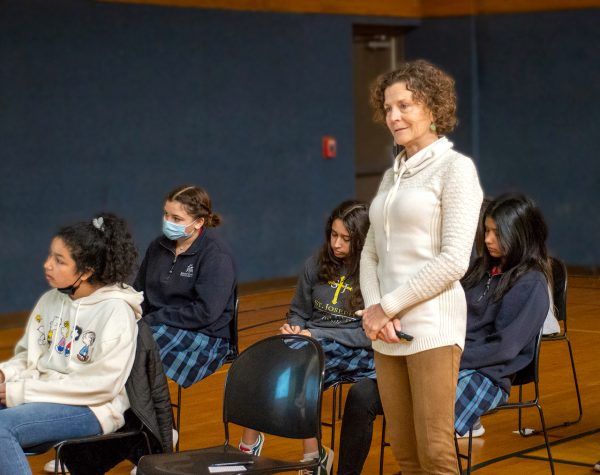Middle school students learning about their emotions and thought processes

Peg Dubrowski listens to a student during a visit to St. Joseph School in Wichita last month to present a program she and Superintendent of Schools Janet Eaton developed to help middle schools students in their emotional and social development. (Advance photo)
Several years ago Peg Dubrowski was monitoring lunch in a St. Louis Catholic school cafeteria with Janet Eaton, the current superintendent of Catholic Schools in the Diocese of Wichita, who was the school principal at that time.
“We said we love these kids! They’re so great!” Dubrowski said. “But there’s so much they’re not learning about how to ‘be’ in this world, how to ‘be’ towards each other and how to control themselves.” So they designed a two-year program to teach the students what the two instructors thought they were missing. “My shorthand for it is ‘teach them how to be human,’” Dubrowski said.
She was working with five diocesan Catholic schools the week of January 17-21 during a visit from her home in St. Louis. Dubrowski’s “On the PATH” program includes nine sessions scheduled throughout the school year in the Diocese of Wichita.
“I am able to go into our Catholic schools and offer social-emotional learning, training, and skills to middle school students,” she said, adding that she is teaching the program using the Catholic faith as its basis. “It makes social-emotional learning even more powerful.”
The program helps middle school students develop awareness about how they function emotionally and their thought processes. “It helps them grow some skills regarding self-regulation and self-discipline, learning to hit the pause button and put off immediate things for a better goal,” Dubrowski said.
The program also helps the youth with:
• Interpersonal skills and conflict resolution
• Managing relationships
• Understanding how their choices and their words and their actions affect others
• Helping them to learn how to approach others (words removed) and find commonalities rather than areas of disagreement.
“They’re highly interactive situations,” she said. “There are lots of games, lots of talking to each other, and some small group work.”
The kids are interesting to watch, Dubrowski said, adding that middle schoolers are the best age group for this work because “their brains have exploded with potential, moving from a very concrete way of thinking to an of abstract, formative way of thinking.” They understand that something has changed in them, she said.
“They latch onto this stuff and they understand that it’s up to them to manage their brain and guide how it’s going to become. They can let the world push them around but if they figure out how to do it from the inside out, that’s how God has intended for all of us.”
